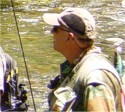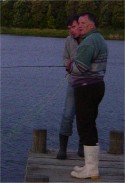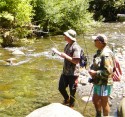This is an article of Herb's which first appeared in NZ Fisherman (1994). He has kindly given me permission to publish it here - Paul
A little while ago Bill Kirk asked me to do a series on fly-casting for future issues of the "Fisherman". Frankly I had to think hard about this suggestion because like any assignment it smacks of many of the characteristics I don't like about work. Deadlines, control from the top, repetition.... I guess you know what I mean.
It was only after I reread some of my previous articles on the subject that I decided that a more organised and better-targeted treatment of fly-casting would benefit more readers.
While I was belly aching about all this I resolved that while the emphasis of this new series will be unavoidably instructional, it should also be self-diagnostic. In other words, instead of me telling you what to do I shall help you understand why you should do it. That way you can become your own doctor and if you so choose go forth and heal others.
There is plenty of scope for the latter because in this game we are all sufferers. Trouble is it takes a whole series to cover the most common ailments.
Lets start with two really basic ones. The grip of your rod and the way you hold it.
You probably do not think about it when you buy a fly rod or while you are fishing but the shape of the grip and how you hold it has a significant bearing on your ability to cast.
Surprised? Well, it is true. Fly-casting is a dynamic precision sport. Once started, the line must be kept moving. Casting involves an intricate set of movements, all carried out with precisely measured amounts of energy and impeccable timing.
Grip Size
The rod grip is the conduit through which the angler transmits his tactile commands to his tackle. Its size is critical for it should weld the rod to the hand so that the rod becomes an uninterrupted extension of the casters arm. Any misfit or discomfort will in some way lessen the control the angler can exercise over the cast. If you have hands like a gorilla a thin grip on a long and powerful rod is a combination you won't enjoy casting with for very long. Think of the flyrod like any other hand tool that if it is to perform efficiently needs to fit well into the hand of its user.
Grip Shape
Grips come also in several shapes. Generally speaking the shape of a fly rod grip is related to the line weight rating of the rod and the way the caster holds the rod. (More about holds later).
The forward tapered cigar shapes (Half Wells) are usually seen on light rods. Such rods are used in fishing situations where accuracy of presentation is most important.
On the other side of the ledger the fuller shapes (Full Wells) enable the caster to apply the power for long casts to rods rated for line weights eight and above.
The Right Grip
The size, regardless of shape, should fit comfortably. The cigar shapes are for light rods, while powerful ones demand fuller shapes.
Holds
Despite the linguistic similarity the rod grip and how the caster grips the rod are not the same.
I know that I will be trespassing here onto strongly held personal views but I hope you will find my analysis of the three principal holds interesting. Some of you may even track down a chronic casting problem by having a closer look at the way you hold your rod. Be particularly alert if you hold the grip with the thumb on top.
Thumb on Top
Despite being recommended in nine out of ten casting books and videos it is without doubt the most difficult hold to do correctly. When it is not done right (which is in my expertise most of the time) then it accounts for tailing loops and sagging back casts. It also makes it easy for the caster to deviate the rod stroke from the vertical plain.
The reason why so many casters get it wrong is not for their lack of grey matter between the eyes but because of the anatomy of the human wrist. Let me show you how this grip can get you into trouble.
Hold the butt of your rod and pretend to do a back cast. Notice how easy it is to rotate your wrist and rod way past the recommended one O'clock position. That is where the sagging back cast comes from.
Now do a forward cast and stop your rod when you shoot your line. Is your thumb pointing at the target? I bet it isn't! More likely it will still be sticking up in the air. If that is so then you did not turn the cast over well enough. Welcome to the club. You have just created a tailing loop and probably a wind knot.
Start again only this time point the thumb at your target. You will immediately feel some discomfort as you bend your wrist forward a little more than it was designed for.
While you are holding the rod like this move its tip horizontally. Easy isn't it. That's why it is so easy with this grip to stray from the vertical casting plain.
You must be wondering why this grip is used at all? Really its big redeeming feature is that by using his powerful thumb the caster can apply the most power to the rod. The "thumb on top" hold is excellent for powerful rods.... provided you are aware of the traps.
A Full Wells shape grip works best as the thumb has a big surface to push against.
The V-Hold
This is the only other hold that is suitable for big water rods. The hold is a bit of a compromise as it allows the thumb and the forefinger to rest on opposite sides of the grip. Viewed from the top their junction forms a V-shape. With this hold it is still quite easy to bend the wrist too far back but the good news is that it also permits you to freely bend the wrist forward for a good turnover. I have a friend who has arthritis in his hands and had to make this switch from the "thumb on top" hold. If you are similarly afflicted try this hold before you decide to give up fishing.
The Forefinger on Top Hold
Frank Schlosser showed me this hold when he lived in Turangi. It felt awkward at first but after a bit of trial it became my automatic small rod hold. The grip is a beauty. With the forefinger on top it locks out all wrist side movement. This keeps the rod in a single casting plane for greater accuracy. Get hold of your rod butt again and try this hold.
When you move the hand back for the back cast you will notice that this hold stops you from bending the wrist too far back.
However, the opposite happens on the forward cast. The wrist tilts forward naturally and without discomfort, making it easy to turn the cast over.
What's more the forefinger literally paints the stroke through the air before pointing accurately at the target. The line just seems to follow where the finger points.
To get the best from this hold lay your forefinger straight along the top without bending. You will notice that this is a lot easier with a forward tapered grip such as a cigar or Half Wells shape.
I have purposely started this series on casting with such peripherals as rod grips and how you should hold them.
After all if you can't get a good grip on your tackle you wont have much control over its performance either. It's that simple.
Herb Spannagl is retired conservation officer and national park ranger with the New Zealand Department of Conservation. Currently councillor for NZ Fish and Game. Married with two adult son and daughter, one cat and one German Wirehaired Pointer. And he throws Sexyloops :-)
Related reading: The Grip in the Casting Manual and Get a Grip in Dirty Harry.










